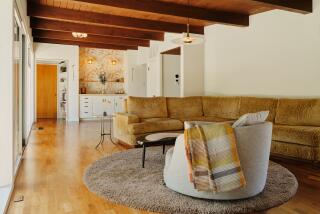Look to the Future When Making Home Purchase
- Share via
Buy the future.
That’s the counsel offered to new-home buyers by experts in the art of tracking design trends and housing demographics.
“What’s happening is that the consumer is changing dramatically,” said Stephen G. Bottfeld, executive vice president of Marketing Solutions, a consumer research firm specializing in real estate.
Obviously, the baby boom generation--whose members are beginning to enter their 50s--will be a major force shaping new-home features.
But what is less obvious is that many boomers are not expected to substantially reduce the size of their housing in later life, Bottfeld said.
“There’s grave doubt that boomers will downsize,” said Bottfeld, who predicts that the typical boomer couple now scales back housing by no more than 25% in the first move after the children reach adulthood.
“We’re not seeing people jumping out of 3,000-square-foot houses into 1,000-square-foot houses,” noted Bottfeld, who advises home builders across the United States on customer preferences.
Why will so few boomers (those born between 1946 and 1964) move to small units in later years? There are several factors that set them apart from past generations, Bottfeld said.
For one thing, an increasing number of boomers will require spacious home offices as they age. Many will need to continue working for financial reasons, if only as part-time consultants. And even those with the means to retire may stay employed part time for the intellectual stimulation, Bottfeld believes.
Aging boomers will also need more space for elderly parents as life spans stretch out. “We’re seeing more and more households where the senior parent lives with a grown daughter or son on a full-time basis,” he said.
As people live longer, the extended family is reemerging, said Tom Hathaway, head of the Buyer’s Agent Inc., a national realty company that represents only purchasers.
Because fewer households are now willing to downshift to significantly smaller homes, Hathaway advises new-home buyers to opt for as much space as they can afford.
In particular, he cautions against buying a one- or two-bedroom home except in areas where such properties are the norm, such as an urban community where condominiums or co-ops are prevalent.
“A home with two bedrooms is limited in space for house guests or grown children who are visiting and is therefore harder to resell,” Hathaway said.
Here are five other suggestions for those buying a newly built home:
* Seek a low-maintenance property.
Boomers may want internal space and lots of it, but they are deeply ambivalent about taking on responsibility for high-maintenance grounds.
“Buyers are asking for big houses, but many say they don’t have time for big yards anymore,” said Hathaway, who calculates that fewer than 10% of home buyers now want more than half an acre.
The Buyer’s Agent, which is based in Memphis and has offices across the country, has surveyed the preferences of more than 45,000 buyers during the last nine years. And with each year’s survey, a diminishing number report the desire for a large yard, because of time pressures.
“People want a smaller yard that’s groomed magnificently,” Hathaway said.
* Look for a first-floor master suite.
An increasing number of new homes are two- or three-story properties because land costs are rising almost everywhere and builders can get more square footage on the same lot if they build vertically rather than horizontally.
Still, many savvy builders are now offering the option of a first-floor master suite. Indeed, some spacious properties are available with two such suites on the primary floor.
Why the interest? Because many boomers with older children like a degree of separation from their noisy teenagers’ rooms. Some are planning ahead for the years when scaling the stairs could be a hardship. And still others want a first-floor suite for an elderly parent.
* Look for high ceilings.
In a society where many are fearful of crime and feel limited in their ability to move about freely, especially at night, the home becomes a valued refuge. And the spacious feeling of high ceilings, particularly those that are at least nine or 10 feet, help many feel less boxed in.
Although homes with eight-foot ceilings have been the standard for years, an increasing number of builders are responding to market demand for loftier rooms, Hathaway noted.
* Try to find a property that doesn’t advertise its garage to the street.
“The front-entry garage is pretty much ‘out.’ People prefer a garage that you enter at the side or the rear of the house,” Hathaway said.
A home with a garage that’s somewhat hidden from view appeals to some as being more aesthetically pleasing. Others like it because it seems less commercial. And still others like the nostalgic feeling it conveys, since garages were typically built behind homes during past decades.
* Look for more open and casual floor plans. “Compartmentalized, formal plans are a thing of the past,” said Dave Schreiner, vice president of marketing for Del Webb Corp., a national building company specializing in communities for active seniors.
Although definitions are loose in the building industry, the “great room” is a term that now typically refers to a large family room that flows gracefully into an informal dining area and large kitchen.
Americans are increasingly enamored of such settings, which are ideal for casual living and entertaining.
Meanwhile, formal living rooms are shrinking in size, or even disappearing, in many floor plans, and more buyers now seem willing to trade off a formal living room for plenty of casual space, Bottfeld said.
“The living room is almost a vestigial organ, like an appendix,” he said.
*
Distributed by Universal Press Syndicate.
More to Read
Inside the business of entertainment
The Wide Shot brings you news, analysis and insights on everything from streaming wars to production — and what it all means for the future.
You may occasionally receive promotional content from the Los Angeles Times.









